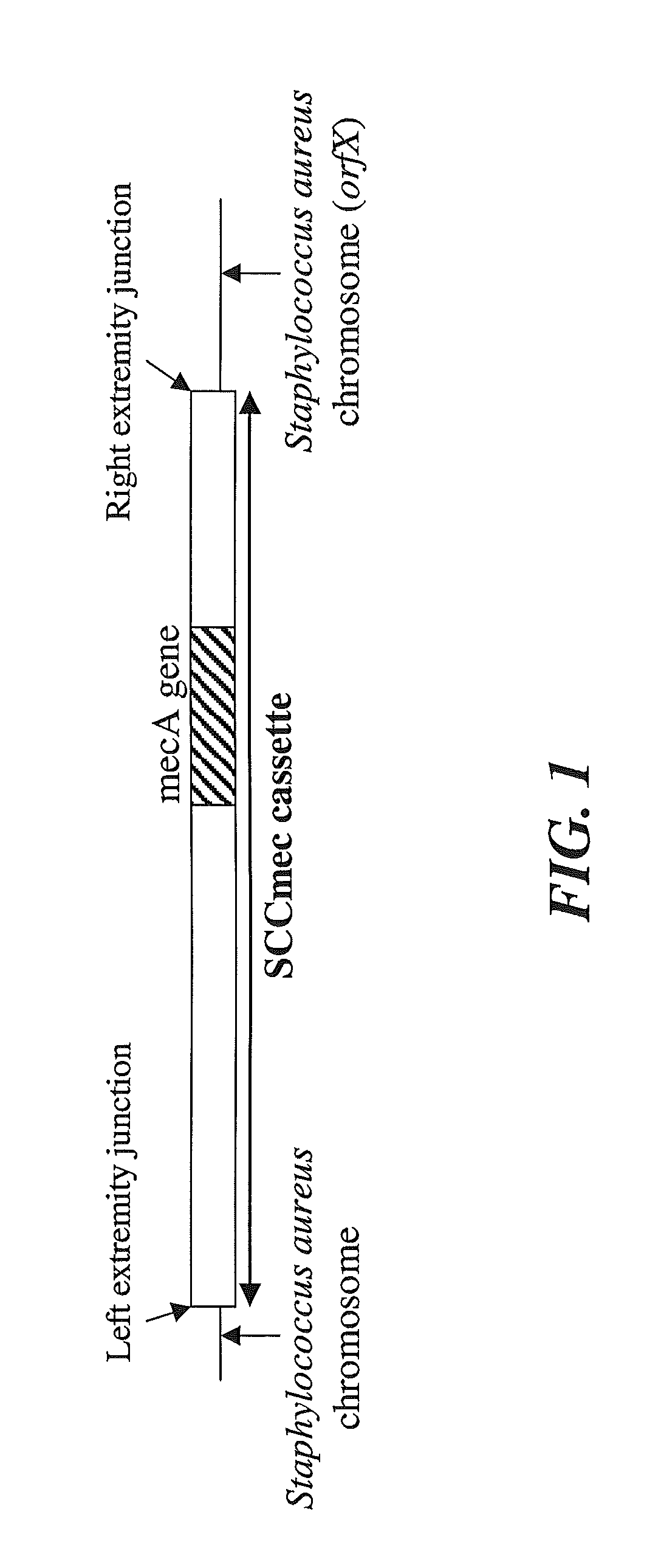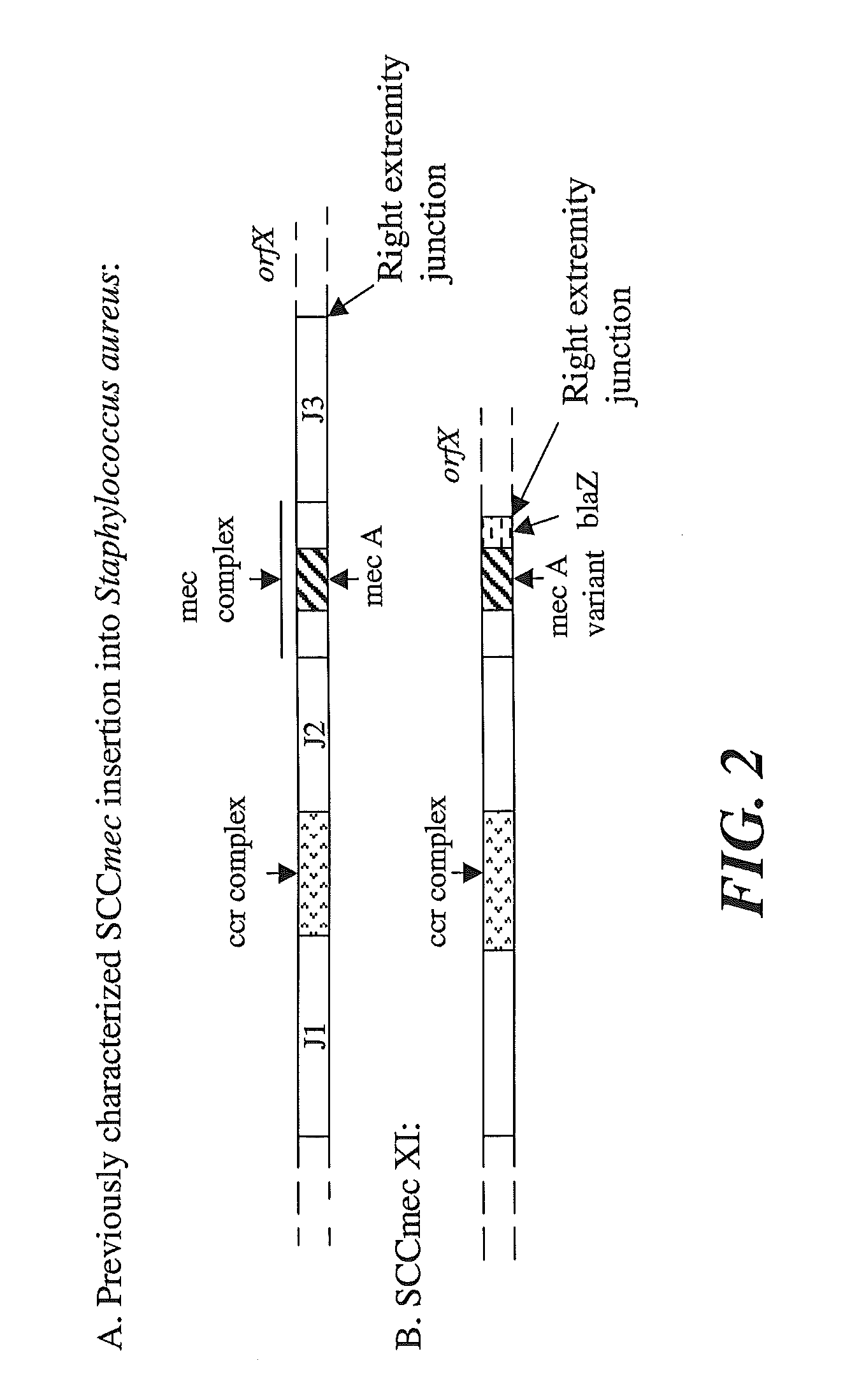Detection of mecA variant strains of methicillin-resistant Staphylococcus aureus
a technology of staphylococcus aureus and meca, which is applied in the field of molecular detection of methicillin-resistant staphylococcus aureus, can solve problems such as false negatives
- Summary
- Abstract
- Description
- Claims
- Application Information
AI Technical Summary
Benefits of technology
Problems solved by technology
Method used
Image
Examples
example 1
Design of mecA Variant Primers and Probes
[0127]Experiments were designed to develop a PCR amplifying the Staphylococcus aureus orfX-mecA variant region. Initially, to design primer(s) on the orfX side of the SCCmec junction, two primers and one probe were designed in the orfX region. A mecA variant-specific set of oligos (for mecALGA251, also described in literature as mecAM10 / 0061, mecA homologue, and mecAnew variant) were also designed. As the mecA variant orientation was initially unknown, we designed mecA variant divergent primers in order to obtain a mecA variant-orfX amplicon. Further candidates on both ends of mecA variant gene have been designed to develop specific PCR of Staphylococcus aureus. The PCR assay selected for mecA variant amplification across the SCCmec junction should generate an amplicon about 1300 nt long. The PCR assay selected for detection of the mecA variant element itself may vary from this amplicon size; for example, it may produce a shorter amplicon.
[01...
example 2
mecA Variant-orfX Amplification Reaction
Standard PCR conditions, as described above, were utilized, unless noted differently.
example 2a
Selection of Primers
[0144]Tests were performed on one mecA variant (+) strain (Internal collection strain number 1156001) at 10 ng / μl, and one mecA(+) strains (ATCC 43300 strain) at 10 ng / μl. Primers tested were:
[0145]orfX MRSA primers:[0146]mecAv-orfX-9 (SEQ ID NO:9): 10 μM[0147]mecAv-orfX-10 (SEQ ID NO:10): 10 μM
[0148]mecA variant 3′-end primers:[0149]mecAv-orfX-6 (SEQ ID NO:6): 10 μM[0150]mecAv-orfX-7 (SEQ ID NO:7): 10 μM
[0151]Conditions for all PCR reactions for primer selection were as follows:[0152]PCR format: 45 μl MIX+5 μl target[0153]PCR conditions: 4 conditions have been tested (see below)[0154]Expand High Fidelity PCR system (Roche, ref 11732650001, Lot Number 11398326)[0155]GeneAmp PCR system 9700
[0156]
TABLE 6PCR 4 tested conditions:TemperatureTimeCycleCondition 1 / thermo n°2055595° C.2min1 cycle95° C.30s55° C.20s30 cycles72° C.30s72° C.7min1 cycle 4° C.infinite1 cycleCondition 2 / thermo n°2055694° C.2min1 cycle94° C.15s55° C.30s30 cycles72° C.45s72° C.7min1 cycle 4° C.inf...
PUM
| Property | Measurement | Unit |
|---|---|---|
| temperature | aaaaa | aaaaa |
| nucleic acid | aaaaa | aaaaa |
| nucleic acid sequence | aaaaa | aaaaa |
Abstract
Description
Claims
Application Information
 Login to View More
Login to View More - R&D
- Intellectual Property
- Life Sciences
- Materials
- Tech Scout
- Unparalleled Data Quality
- Higher Quality Content
- 60% Fewer Hallucinations
Browse by: Latest US Patents, China's latest patents, Technical Efficacy Thesaurus, Application Domain, Technology Topic, Popular Technical Reports.
© 2025 PatSnap. All rights reserved.Legal|Privacy policy|Modern Slavery Act Transparency Statement|Sitemap|About US| Contact US: help@patsnap.com


